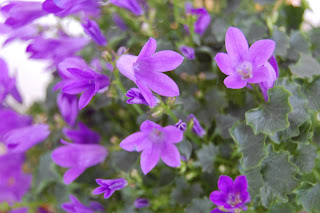The Fairy Bellflower (Campanula)
In Spring garden centres and supermarkets fill with an array of
beautiful plants to tempt and inspire us. One of the most brightly coloured and
prolifically flowered of these plants is usually generically labelled as Campanula,
which actually refers to a family of flowers. Its Latin name derives from the
bell shape of its flowers for campanula means 'little bell' and in
times past these plants were also known as Fairy Bellflowers or Fairy Bells. Another
name for Campanulas is Fairy Caps for some Faeries are said to wear the flowers
like hats.
The bell shaped flowers open to a five pointed star which means
that these purple flowers are linked with the symbolism of that most Witchy of
symbols, the Pentagram. Just as the Pentagram is a symbol of magic, protection,
the five elements (Earth, Air, Fire, Water & Spirit), our five senses and
the Goddess so too are Bellflowers. The Purple/Blue hue of many Campanulas is
associated with Spirituality, the Faerie Path, the Goddess, Mysteries and Magic,
although they also come in white and pink.
One species, Campanula
rapunculus, aka Rampion Bellflower, which was once widely grown in Europe
as a vegetable, inspired the name of one of our most famous Fairy Tale
characters - Rapunzel which has long stems as she had long hair. Another
variety, Campanula cochleariifolia,
has the common name of Fairies' Thimbles for they are said to be used by Faerie
seamstresses to protect their fingers while sewing. In England the best known variety, Campanula rotundifolia, is
commonly known as the Harebell and in Scotland as the bluebell.
Like English Bluebells Campanulas are said to ring to call Fairies to their revels
and ring out on the major Fairy Festivals. The Harebell Fairy, with her
Harebell skirt, was one of the Flower Fairies that Cicely Mary Barker painted for her much loved book 'Flower Fairies of the Summer'.
There are over 500 different species
of Fairy Bellflower ranging from the dwarf varieties that are only a few centimetres
high to vast plants that grow up to 2 metres tall. They can be found all the
way from the Arctic down to North Africa and from Western Europe across to Asia.
Campanulas can be grown indoors or outdoors (depending on the species) from seed or purchased as grown plants and make a wonderful addition to Faerie Altars or Faerie Gardens as Faeries flock to their wonderful, uplifting and deeply spiritual energy.
Campanulas can be grown indoors or outdoors (depending on the species) from seed or purchased as grown plants and make a wonderful addition to Faerie Altars or Faerie Gardens as Faeries flock to their wonderful, uplifting and deeply spiritual energy.
The Song of the Harebell Fairy by Cicely Mary Barker
“O bells, on stems so thin and fine!
No human ear
Your sound can hear,
O lightly chiming bells of mine!
No human ear
Your sound can hear,
O lightly chiming bells of mine!
When dim and dewy twilight falls,
Then comes the time
When harebells chime
For fairy feasts and fairy balls.
Then comes the time
When harebells chime
For fairy feasts and fairy balls.
They tinkle while the fairies play,
With dance and song,
The whole night long,
Till daybreak wakens, cold and grey,
And elfin music fades away.”
With dance and song,
The whole night long,
Till daybreak wakens, cold and grey,
And elfin music fades away.”



Comments
Post a Comment